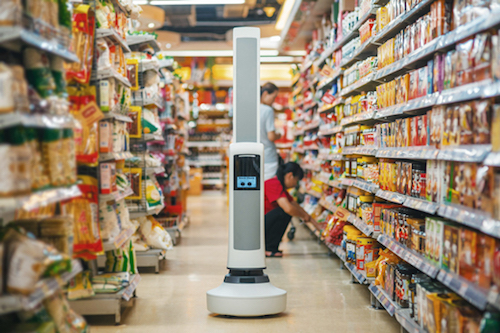In St. Louis, a midwestern grocery chain is making news with its test run of an inventory-taking robot, called Tally by its manufacturer. The machine is not unrelated to the LoweBot-type machine that guides customers to desired items [1] in the store which the robot has filed in its database of what and where. The Tally just rolls around and counts, creating a list of what needs restocking.
The Tally robot scoots around stores to check inventory and verify prices.

The robot won’t actually be restocking the shelves because that task requires the dexterity of the human hand — for now at least. But developers are engaged in a race to build a machine that can move objects around as well as a person. Ground zero for that technology is the Amazon Robotics Challenge [2], an annual contest for a robot that can physically pack an order into a box for shipment (which is taking place this week [3], as it happens). A machine that can pick and pack like a human hand will have a lot of job-killing applications beyond the Amazon warehouse.
The Tally robot is a creation of Simbe Robotics [4] in San Francisco. The company has a pleasantly reassuring video with a Strauss waltz playing — though there’s no mention of the jobs lost since a human with a clipboard is no longer needed.
The retail business is about to be transformed by automation [5], including the shopping experience for consumers, and the result will be severe job loss. Hardest-hit will be cashiers, because self-checkout is a simple technology. In May, the financial services firm Cornerstone Capital Group forecast that between 6 million to 7.5 million retail jobs are at risk of being automated [6] over the next 10 years. What are those people supposed to do for a living when the same technological forces are knocking many other unskilled jobs? President Trump’s efforts at increasing jobs are having an effect, but the long term looks unpromising.
Eric Brynjolfsson, tech author from MIT, recently remarked about the revolution in retail (Amazon’s Move Signals End of Line for Many Cashiers [7], NYTimes, June 17, 2017):
“Amazon didn’t go put a robot into the bookstores and help you check out books faster. It completely reinvented bookstores. The idea of a cashier won’t be so much automated as just made irrelevant — you’ll just tell your Echo what you need, or perhaps it will anticipate what you need, and stuff will get delivered to you.”
The shopping experience that tech wizards are designing sounds pretty sterile, but it would be an improvement over sales helpers who don’t speak English well (as I reflected yesterday while shopping for manila folders at Staples).
The future will automated. To prepare for it, the least Washington could do is severely limit immigration, say by about 99 percent, because AUTOMATION MAKES IMMIGRATION OBSOLETE.
The robot invasion has begun in the grocery aisle [8], New York Post, July 27, 2017
A family-owned grocery chain in the Midwest is set to test an aisle-roving robot, joining technology-savvy retail behemoths like Amazon and Walmart.
The robot, named Tally, will begin scanning store aisles at three St. Louis-area Schnucks grocery stores in a six-week pilot program starting on Monday. The robot will check aisles three times a day to look for out-of-stock items and make sure items and price tags properly correspond, company officials say.
“We’re excited to see what this partnership brings,” Dave Steck, the chain’s vice president of IT and infrastructure, said in a statement [9] on its collaboration with San Francisco-based Simbe Robotics. “This is just one of many ways that Schnucks is staying at the forefront of technology to enhance our customers’ shopping experiences.”
Schnucks — which operates more than 100 stores in Missouri, Illinois, Indiana, Wisconsin and Iowa — will initially use the adjustable 38-inch, 30-pound robot to monitor items on store shelves but is hopeful that the robot “may open up a world of other possibilities” with the data it collects, Steck said.
The robots are the first test of the technology in Missouri and could expand to other Schnucks locations, the St. Louis Post-Dispatch reports [10].
Simbe CEO Brad Bogolea told the newspaper that the robot’s ability to find items that need to be restocked and pricing errors allows employees to focus on other tasks. The robot has already been scanning aisles in other stores across the country, including some Target stores in San Francisco last year.
“The goal of Tally is to create more of a feedback mechanism,” Bogolea told the newspaper. “Although most retailers have good supply chain intelligence, and point-of-sale data on what they’ve sold, what’s challenging for retailers is understanding the true state of merchandise on shelves. Everyone sees value in higher quality, more frequent information across the entire value chain.”
Steck, meanwhile, said the robot isn’t being tested to one day replace human employees.
“This is not to displace jobs,” he told the Post-Dispatch. “It still takes someone to order [merchandise], receive it from the warehouse and ultimately to stock it. There are no arms or legs on this robot.”
Amazon, which announced last month it will acquire Whole Foods, is planning to slash cashier jobs as part of an overall strategy [11] to automate jobs and cut prices, Bloomberg reported. An Amazon spokesman denied that job cuts were planned at Whole Foods.
A source told The Post in February that Amazon planned to “utilize technology to minimize labor” [12] at new, automated supermarkets that could operate with as few as three employees.
Walmart, meanwhile, has also filed a patent to use drones in its stores [13], which would allow the flying robots to “carry the item of inventory to a delivery area” located within the store, according to a patent application.